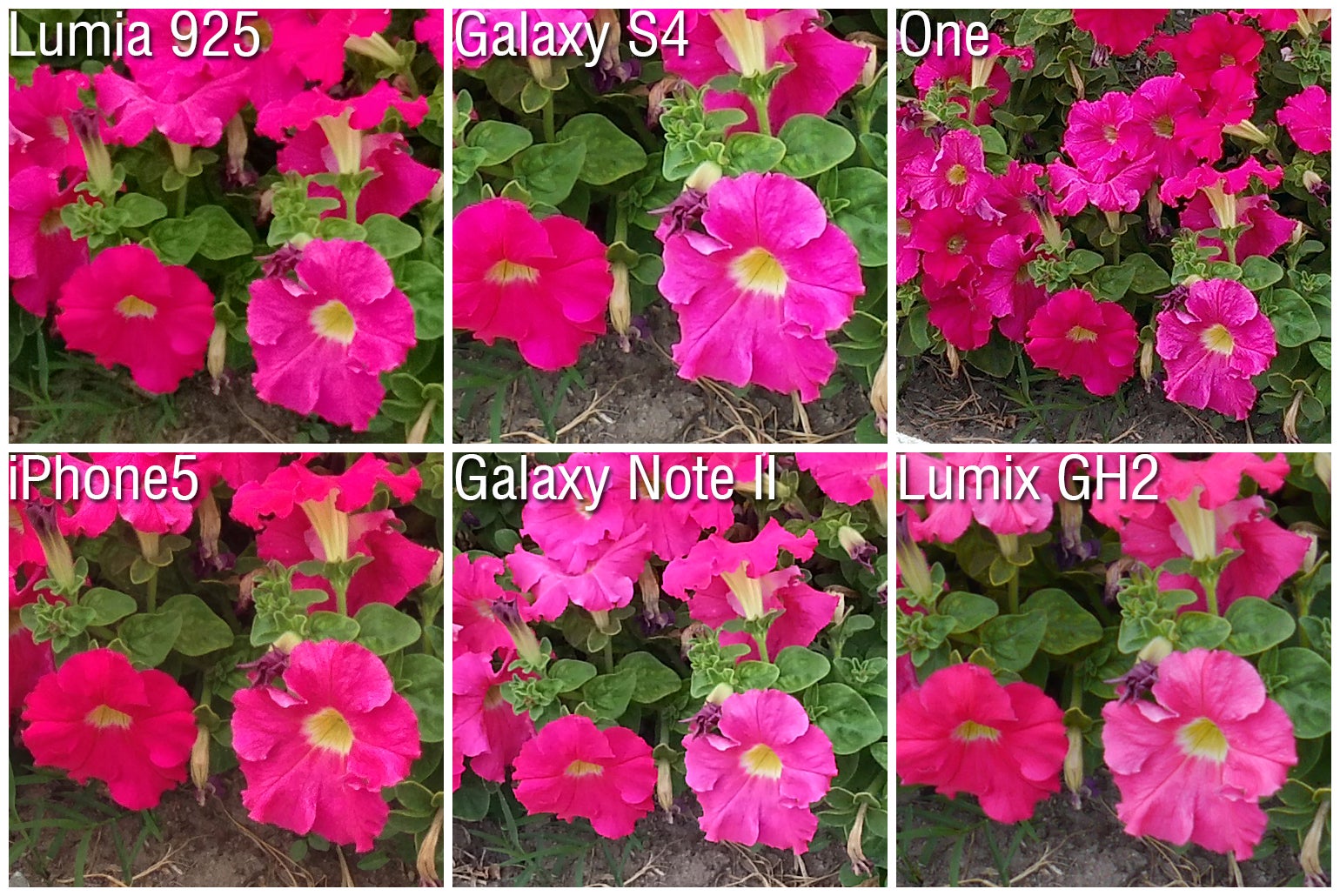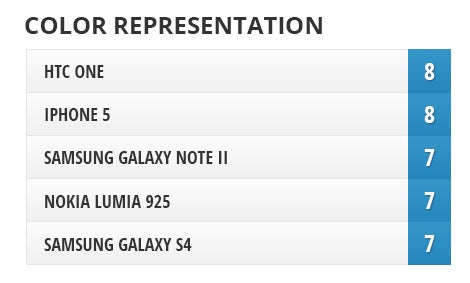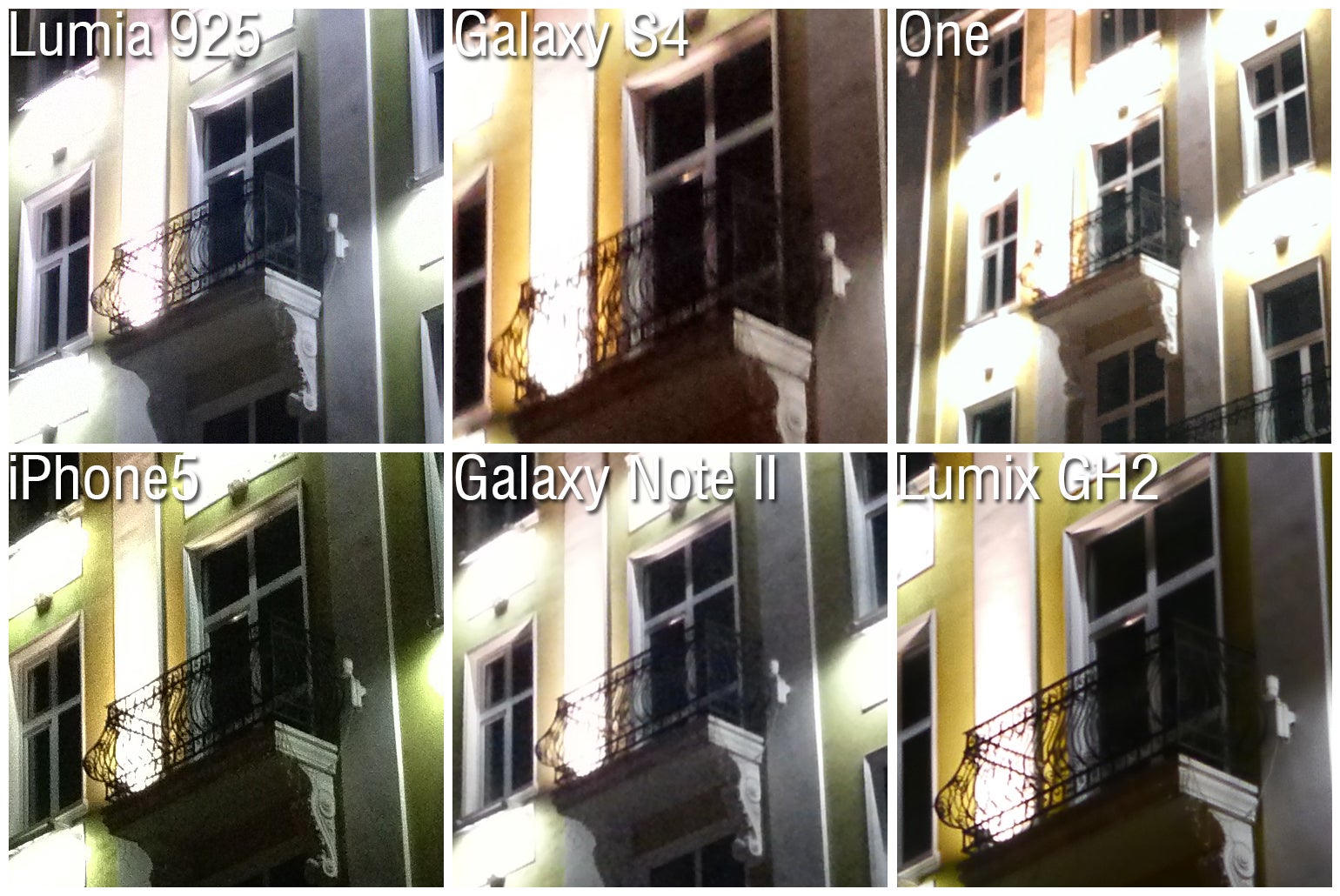Camera comparison: Nokia Lumia 925 vs Samsung Galaxy S4, HTC One, iPhone 5, Samsung Galaxy Note II

You can now read:
- LG G2 vs Samsung Galaxy S4 vs iPhone 5 vs HTC One Camera comparison
- iPhone 5s vs LG G2 vs Samsung Galaxy Note 3 vs Galaxy S4 vs HTC One vs Motorola Moto X vs DROID Ultra Camera comparison
- Google Nexus 5 vs iPhone 5s vs Sony Xperia Z1 vs Samsung Galaxy Note 3 vs Galaxy S4 vs LG G2 vs Nokia Lumia 1020 vs HTC One Camera comparison
Not many of Nokia’'s smartphones are worthy of bearing the PureView badge. The title is given to only the maker’'s best cameraphones, among which is the Nokia Lumia 920 from last year. This particular smartphone, however, wasn'’t quite as capable as the competition, and an extensive camera comparison that we did a while ago proved that.
So yeah, the Nokia Lumia 925 is supposed to be a great cameraphone, but is that really the case? And is the smartphone's camera as potent as those on the current high-ends? Well, that’s what we’re here to find out. We'’ve brought along a handful of smartphones to compare the 925 against – the 13MP Samsung Galaxy S4, the HTC One with its 4MP “Ultrapixel” camera, the iPhone 5 with its 8MP snapper, and the Samsung Galaxy Note II packing an 8MP camera. All of these devices are known to be pretty decent cameraphones, so the battle will surely be heated. Oh, and there’s also a Panasonic Lumix GH2 thrown in – a stand-alone, Four Thirds digital camera with its stock 14-42mm lens, serving the purpose of a reference device.
With that out of the way, let’ us get this camera comparison started!
Overall presentation:
Before we dive into details, let us first take a look at some scaled-down photos. All of the images here have been downsized to a width of only 1920px as that's sufficient for most people'’s needs. The goal of this is to present the photographs from a typical user'’s point of view. That'’s how the average Joe would view and use them – posted on a social network or a photo sharing web site, for example. And by the way, a digital photo of this size is perfectly suitable for making 6”” by 4”” hard copies. They all look pretty nice, don'’t they? At low resolutions, many of the imperfections associated with smartphone photography, such as digital noise and inadequate detail levels, are barely noticeable. Other factors, however, are still into play.
The Nokia Lumia 925 pleased us with its balanced performance. Its photos have pretty accurate exposure and color representation, but could use a little bit more detail. Even better results are delivered by the Samsung Galaxy S4 and Note II, which manage to pack a great amount of detail in their photos, all the while retaining the color saturation down to a neutral level. The pictures captured with the iPhone 5 have an overall warmer tone, but they still look very pleasing to the eye. Besides, this is the smartphone producing best indoor photos, given enough light, of course. As for the HTC One, its camera gets the job done and has the most neutral color balance, but some scenes aren't exposed sufficiently.

Details:
Now it is time to take a closer look at some full-resolution photos. Somewhat unsurprisingly, the Samsung Galaxy S4 pleased us the most with its sharp, detailed shots. Digital noise is mostly unnoticeable in its photos even when they are viewed at 100% zoom. Close behind it are the Samsung Galaxy Note II and the iPhone 5, both of which are capable of capturing photos that are almost as detailed as the S4's. The Nokia Lumia 925 performs well, but its photos aren't as sharp as we wish they were. Details are too soft for our taste, but at least the presence of digital noise is kept under good control. The HTC One, on the other hand, has a tendency of boosting the sharpness of its photos too much, resulting in the appearance of unwanted artifacts throughout the image. On top of all that, areas outside of the image's center are sometimes blurry for some reason.

Color representation:
We had a hard time picking a winner in this category as all phones delivered similar results. In most of the scenes that we shot throughout our testing, all devices managed to capture near life-like colors. Not a single one of them, however, was flawless. The Nokia Lumia 925, in particular, proved itself as a worthy competitor. We're glad to see that it does not boost the color saturation as much as the 920 has a tendency to, although there is some slight exaggeration going on when it comes to displaying shades of pink. The latter issue is present in the Galaxies' photos as well. The HTC One is a lot better at capturing warmer tones accurately, but it has a harder time capturing white objects in detail, as you can see from the sample images below. As for the iPhone 5, its photos look nice in general, but often have a warmer than normal temperature.

100% crop

Dynamics range and exposure:
If there's one thing that the Nokia Lumia 925 does well, that is to expose photographs accurately, all the while capturing as much of the dynamics range as it is capable of. Actually, that's the smartphone delivering best results in this category, followed closely by the Samsung Galaxy S4, the Samsung Galaxy Note II, and the iPhone 5. These three phones are also capable of producing well-exposed images under a wide range of circumstances, but the 925 is a step ahead in this department. As for the HTC One, the smartphone has a tendency of leaving out areas a tad underexposed, thus making them appear darker than they should.

Close-ups:

100% crop

Indoor photos:
Given enough light, every smartphone can snap a presentable photo, yet these optimal conditions rarely exist when shooting indoors. Nevertheless, the best smartphones should be able to capture decent photographs even in low light.
The Nokia Lumia 925 is advertised as a great low-light shooter, but it looks like it doesn't quite stand above the rest. When light is plentiful, its photos are of average quality – well exposed, but noisy. The Samsung Galaxy S4 and the iPhone 5, on the other hand, produce clear, detailed photographs, and we'd rather stick with these two when shooting indoors. The HTC One's indoor photos are mostly okay and they are definitely usable. Last on the list ranks the Samsung Galaxy Note II, which struggles in low light, producing blurry images with inaccurate colors.

Strong light 100% crop

Even after we dimmed the lights down further, the Nokia Lumia 925 couldn't outshine the competition. Again, its photos are of acceptable quality, but pack a lot of noise and the LED flash fails to illuminate the entire scene. Results from the Samsung Galaxy S4, the Note II, and the HTC One may vary drastically depending on how much light is present and whether the phone decides to use its LED flash. The iPhone 5's low light photos are noisy, bur are clearly the most usable.

Low light 100% crop

Night photos:
Taking photos at night is a challenge for every smartphone's camera. The Nokia Lumia 925, however, did well in most scenes and its night shots were usually better than the competition's. Actually, results may vary drastically depending on what's being photographed, how well it is illuminated, and how good the photographer is at holding a phone steadily, which explains why the Samsung Galaxy S4's night photos look better than the 925's in some cases. Under ideal conditions, the HTC One can take good night shots, but in reality, it often overexposes the light source and a noticeable amount of blurriness is sometimes present in the frame. The iPhone 5's night photos are usually acceptable despite all the digital noise present in them. As for the Samsung Galaxy Note II, its night shots are mostly okay, although nothing groundbreaking.

100% crop

Video:
All of the smartphones we're comparing can take 1080p video at 30 frames per second, which is now the norm for high-end handsets. And when the light conditions are favorable, all of them are capable of capturing smooth, detailed footage, with the exception of the HTC One. As the case was with some of its photos, there's a weird blur appearing near the frame's outer sides, which is unacceptable for a smartphone of this grade. Thankfully, this phenomenon is noticeable only if you take a careful look at its videos.
Low-light videos from all five smartphones turned out mostly okay, but worse than we expected. The 925's footage is extremely noisy and with cold, lifeless colors at night. The Samsung Galaxy S4 and the Galaxy Note II capture colors accurately, but have a hard time keeping the focus in place in case there isn't enough light present, while the HTC One's night video is choppy, with lights that are often overblown. Videos taken with the iPhone 5 in low-light conditions look okay – noisy, but passable.
As for the sound captured by these smartphones' microphones, the Nokia Lumia 925 and the HTC One are leagues above the rest. Thanks to their high-tech microphones, a wider range of the frequency spectrum can be captured clearly, even at high volume levels. The audio capturing skills of the Galaxies are average at best, while the iPhone 5 performs poorly, recording audio that's faint and difficult to understand.

Camera Interface and ease of use:
Having a high-quality camera on a smartphone is just a single part of the whole equation. Being able to use that camera effectively is also pretty important, and that usually depends on how well the camera interface has been organized.
The Nokia Lumia 925 is the only smartphone of the bunch offering a dedicated, 2-stage shutter button, so it feels and acts a lot like a camera when it is being used as one. The shutter key can be used not only to focus and to capture the photo, but also to launch the camera app even from the lock screen, which is really convenient. The handset is very comfortable to hold horizontally while shooting thanks to its shape, and since the camera sensor is positioned close to the phone's middle section, there is little chance of the user accidentally obscuring its field of view. While shooting portraits, however, our finger often got into the frame, which was annoying. Also, the lens will require regular wiping as the user's finger rests right on it pretty much all of the time while the phone is in use.
The Samsung Galaxy S4 doesn't have a shutter button, but its volume down key can be used as one. Launching its camera from the lock screen is possible by placing a shortcut on it. The user has to do that manually, however, as lock screen shortcuts are disabled on the S4 by default.
The HTC One's has a very slim profile so it isn't as comfortable to hold while taking photos, but we don't think that's too big of a deal unless the user has severe butterfinger problems. A lock screen shortcut for launching the camera is set up by default. There is no physical shutter button, however, so one has to rely solely on the virtual one.
Browsing through the camera settings menu can be confusing at first as all of the settings are placed in a single list. There are several shooting scenes available there, along with controls for the camera's sharpness and exposure levels. Something really cool about the HTC One's camera is that it captures 120fps slow-motion video, as well as 60fps HD video. HDR videos are also an option.
The iPhone 5 doesn't have a shutter key either, but its volume down key can be used as one. Its camera can be easily launched straight from the lock screen. Even with the new iOS 7, the camera UI has retained its simplicity so even a beginner can start using it straight away. Switching between photo and video modes is done with a swipe, and a number of image filters come pre-loaded. Those who are into tweaks and settings are in for a disappointment as no manual controls are available on the iPhone 5, but at least the built-in HDR and Panorama photo modes work quite well.
Last but not least we have the Samsung Galaxy Note II, which is very similar to the S4 in terms of camera features. Its camera can be launched from the lock screen and the volume down button can serve the purpose of a shutter key. Lots of image adjustment setting are available for those who like to experiment with these, and the list of advanced camera features includes Panorama and HDR photo modes. A software image stabilizer is present as well, available both while shooting photos and videos.
Conclusion:

Overall, the Samsung Galaxy S4 and the iPhone 5 are still a notch ahead of the Lumia 925 and competition with their sharp, detailed photographs. No matter the circumstances, these two handsets always manage to present us with results that are well above the average in terms of quality.
The HTC One and its so-called Ultrapixel camera behaved strange as always during our testing. Some of our test shots were spoiled by the fact that certain areas of the image appeared blurry. In other scenes, however, the HTC One delivered pretty good results. Overall, the camera is capable, but twitchy, and might require manual fine-tuning in order to capture a given scene in the best way possible.
As for the Samsung Galaxy Note II, it is still all-around decent camera that excels in taking daytime shots and videos. Low-light scenes, however, are its weakness, so don't count on the Note II if you'll be shooting at a club or out at night with it.

Software versions of the smartphones used in the comparison:
Nokia Lumia 925: Windows Phone 8.0, OS version: 8.0.10327.77
Samsung Galaxy S4: Android 4.2.2 Build JDQ39.I9505XXUAMD3
HTC One: Android 4.1.2 Software number: 1.29.401.12
iPhone 5: iOS 7.0 Beta 1
Samsung Galaxy Note II: Android 4.1.2, Build JZO54K.N7100XXDMB6

You can now read:
- LG G2 vs Samsung Galaxy S4 vs iPhone 5 vs HTC One Camera comparison
- iPhone 5s vs LG G2 vs Samsung Galaxy Note 3 vs Galaxy S4 vs HTC One vs Motorola Moto X vs DROID Ultra Camera comparison
- Google Nexus 5 vs iPhone 5s vs Sony Xperia Z1 vs Samsung Galaxy Note 3 vs Galaxy S4 vs LG G2 vs Nokia Lumia 1020 vs HTC One Camera comparison
Follow us on Google News













Things that are NOT allowed:
To help keep our community safe and free from spam, we apply temporary limits to newly created accounts: